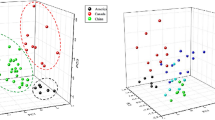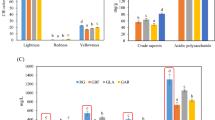Abstract
The quality of pharmaceutical products such as ginseng is important for ensuring consumer safety and efficacy. Ginseng is an expensive herb, and adulteration with other cheaper products may occur. Quality assurance of ginseng is needed since many of its commercial products now come in various formulations such as capsules, powder, softgels and tea. Thus traditional means of authentication via smell, taste or physical appearance are hardly reliable. Herbs like ginseng tend to exhibit characteristic infrared fingerprints due to their different chemical constituents. Here we report for the first time a rapid means of distinguishing American and Asian ginsengs from two morphological fakes – sawdust and Platycodon grandiflorum, via pattern differences and principal component analysis of their infrared spectra. Our results show that ginseng can be distinguished from both sawdust and Platycodon grandiflorum, hence there is a potential of using infrared spectroscopy as a novel analytical technique in the authentication of ginseng.
Similar content being viewed by others
References
Li W., Fitzloff J.F. (2002) HPLC determination of ginsenosides content in ginseng dietary supplements using ultraviolet detection. J. Liq. Chrom. & Rel. Technol. 25: 2485–2500
Fuzzati N. (2004) Analysis methods of ginsenosides. J. Chromatogr. B Analyt. Technol. Biomed. Life Sci. 812: 119–133
Mihalov J.J., Marderosian A.D., Pierce J.C. (2000) DNA identification of commercial ginseng samples. J. Agric. Food Chem. 48:3744–3752
Lum J.H., Fung K.L., Cheung P.Y., Wong M.S., Lee C.H., Kwok F.S., Leung M.C., Hui P.K., Lo S.C. (2002) Proteome of Oriental ginseng Panax ginseng C.A. Meyer and the potential to use it as an identification tool. Proteomics 2: 1123–1130
Li W., Fitzloff J.F. (2002) HPLC with evaporative light scattering detection as a tool to distinguish Asian ginseng (Panax ginseng) and North American ginseng (Panax quinquefolius). J. Liq. Chrom. & Rel. Technol. 25:17–27
Yun T.-K. (2001) Brief introduction of Panax ginseng C.A. Meyer. J. Korean Med. Sci. 16(Suppl): S3–S5
Plotnikoff G.A., McKenna D., Watanabe K., Blumenthal M. (2004) Ginseng and warfarin interactions. Ann. Intern. Med. 141: 893–894
Li Y.-M., Sun S.-Q., Zhou Q., Qin Z., Tao J.-X., Wang J., Fang X. (2004) Identification of American ginseng from different regions using FT-IR and two-dimensional correlation IR spectroscopy. Vib. Spectrosc. 36: 227–232
Shangguan D., Han H., Zhao R., Zhao Y., Xiong S., Liu G. (2001) New method for high-performance liquid chromatographic separation and fluorescence detection of ginsenosides. J. Chromatogr. A 910: 367–372
Wang X., Sakuma T., Asafu-Adjaye E., Shiu G.K. (1999) Determination of ginsenosides in plant extracts from Panax ginseng and Panax quinquefolius L. by LC/MS/MS. Anal. Chem. 71:1579–1584
Vuksan V., Stavro M.P., Sievenpiper J.L., Koo V.Y., Wong E., Beljan-Zdravkovic U., Francis T., Jenkins A.L., Leiter L.A., Josse R.G., Xu Z. (2000) American ginseng improves glycemia in individuals with normal glucose tolerance: Effect of dose and time escalation. J. Am. Coll. Nutr. 19: 738–744
Li W., Gu C., Zhang H., Awang D.V.C., Fitzloff J.F., Fong H.H.S., van Breemen R.B. (2000) Use of high-performance liquid chromatography-tandem mass spectrometry to distinguish Panax ginseng C.A. Meyer (Asian ginseng) and Panax quinquefolius L. (North American ginseng). Anal. Chem. 72: 5417–5422
Yang D.C., Choi Y.E. (2000) Production of transgenic plants via Agrobacterium rhizogenes-mediated transformation of Panax ginseng. Plant Cell Rep. 19: 491–496
Choi Y.E., Yang D.C., Kusano T., Sano H. (2001) Rapid and efficient Agrobacterium-mediated transformation of Panax ginseng by plasmolyzing pre-treatment of cotyledons. Plant Cell Rep. 20: 616–621
Harkey M.R., Henderson G.L., Gershwin M.E., Stern J.S., Hackman R.M., Yuan C.S., Wu J.A., Osinski J. (2001) Variability in commercial ginseng products: an analysis of 25 preparations. Am. J. Clin. Nutr. 73: 1101–1106
Davidson V.J., Li X., Brown R.B. (2004) Forced-air drying of ginseng root: 1. Effects of air temperature on quality. J. Food Eng. 63:361–367
Ngan F.N., Shaw P.C., But P.P.H., Wang J. (1999) Molecular authentication of Panax species. Phytochemistry 50: 787–791
Baulsir C.F., Simler R.J. (1996) Design and evaluation of IR sensors for pharmaceutical testing. Adv. Drug Deliv. Rev. 21:191–203
Liu Y., Xie M.X., Kang J., Zheng D. (2003) Studies on the interaction of total saponins of Panax notoginseng and human serum albumin by Fourier transform infrared spectroscopy. Spectrochim. Acta A Mol. Biomol. Spectrosc. 59:2747–2758
Kerslake E.D.S., Wilson C.G. (1996) Pharmaceutical and biomedical applications of fiber optic biosensors based on infra red technology. Adv. Drug Deliv. Rev. 21: 205–213
Pavia D.L., Lampman G.M., Kriz G.S. Infrared Spectroscopy. In: Shur L., Fitz-Hugh S. and Kiselica S. (Eds.), Introduction to Spectroscopy: A Guide for Students of Organic Chemistry. Harcourt Brace College Publishers, Washington, U.S.A., 1996, pp. 14–95
Woo Y.-A., Kim H.-J., Cho J.H. (1999) Identification of herbal medicines using pattern recognition techniques with near-infrared reflectance spectra. Microchem. J. 63: 61–70
Blanco M., Coello J., Eustaquio A., Iturriaga H., Maspoch S. (1999) Analytical control of pharmaceutical production steps by near infrared reflectance spectroscopy. Anal. Chim. Acta 392:237–246
Davies, A.M.C.T. and Fearn, T. (2005) Back to basics: The principles of principal component analysis. Retrieved from Spectroscopy Europe. Tony Davies Column. 16: 20–23 http://www.spectroscopyeurope.com/TD_16_6.pdf 07/10/2006
Chaminade P., Baillet A., Ferrier D. (1998) Data treatment in near infrared spectroscopy. Analusis Mag. 26: M33-M38
Torgrip R.J.O. (2003) Chemometric analysis of first order chemical data. Department of Analytical Chemistry, Stockholm University, Sweden
Landau S., Everitt B.S. (2004) A handbook of statistical analyses using SPSS. Chapman & Hall/CRC Press LLC, Florida, p 354
Freer J., Ruiz J., Peredo M.A., Rodríguez J., Baeza J. (2003) Estimating the density and pulping yield of E. globulus wood by DRIFT-MIR spectroscopy and principal components regression (PCR). J. Chil. Chem. Soc. 48:N3
Stalker, I. and Applefield, M. (2002) The preservation of wood, a self-study manual for wood treaters. Retrieved from http://www.extension.umn.edu/distribution/naturalresources/DD6413.html 07/10/2006, part of University of Minnesota Extension Service. http://www.extension.umn.edu/index.html 07/10/2006
Kurtzweil, P. Fake food fight. FDA Consumer Magazine, March-April 1999. Retrieved from http://www.fda.gov/fdac/features/1999/299_food.html 07/10/2006, part of FDA homepage. http://www.fda.gov/ 07/10/2006
Saeki T., Koike K., Nikaido T. (1999) A comparative study on commercial, botanical gardens and wild samples of the roots of Platycodon grandiflorum by HPLC analysis. Planta Med. 65: 428–431
Yao S.-C., Wang L.-L., Yeung S.C.-S. In: Chang H.-M. and But P.P.-H. (Eds.) Pharmacology and Applications of Chinese Materia Medica. World Scientific Publishing Co. Pte. Ltd., Hong Kong, China, 1986
Kim Y.S., Kim J.S., Choi S.-U., Kim J.S., Lee H.S., Roh S.H., Jeong Y.C., Kim Y.-K., Ryu S.Y. (2005) Isolation of a new saponin and cytotoxic effect of saponins from the root of Platycodon grandiflorum on human tumor cell lines. Planta Med. 71:566–568
Dharmananda, S. (2002) The nature of ginseng: From traditional use to modern research. Retrieved from Internet Journal of the Institute for Traditional Medicine and Preventive Health Care. http://www.itmonline.org/journal/arts/ginsengnature.htm 07/10/2006, part of the Internet Journal of the Institute for Traditional Medicine Homepage. http://www.itmonline.org/journal/ 07/10/2006
Schulten H.-R., Soldati F. (1981) Identification of ginsenosides from Panax ginseng in fractions obtained by high-performance liquid chromatography by field desorption mass spectrometry, multiple internal reflection infrared spectroscopy and thin-layer chromatography. J. Chromatogr. A 212: 37–49
Acknowledgement
The authors would like to thank Mr. Ranjit Viswanathan (Sales Manager, CAMO Software India Pvt. Ltd.) who permitted the download of ‘The Unscrambler® 9.2′ software evaluation version for analysis of our data.
Author information
Authors and Affiliations
Corresponding author
Rights and permissions
About this article
Cite this article
Yap, K.YL., Chan, S.Y. & Lim, C.S. Authentication of traditional Chinese medicine using infrared spectroscopy: distinguishing between ginseng and its morphological fakes. J Biomed Sci 14, 265–273 (2007). https://doi.org/10.1007/s11373-006-9133-3
Received:
Accepted:
Published:
Issue Date:
DOI: https://doi.org/10.1007/s11373-006-9133-3




